So, it’s time for you to become a software project manager.
But you don’t have a relevant degree, experience, or technical background…
Is it even possible to become a project manager in an IT company like that?
Yes, it is! Below, you’ll find a full guide on how to become a software PM.
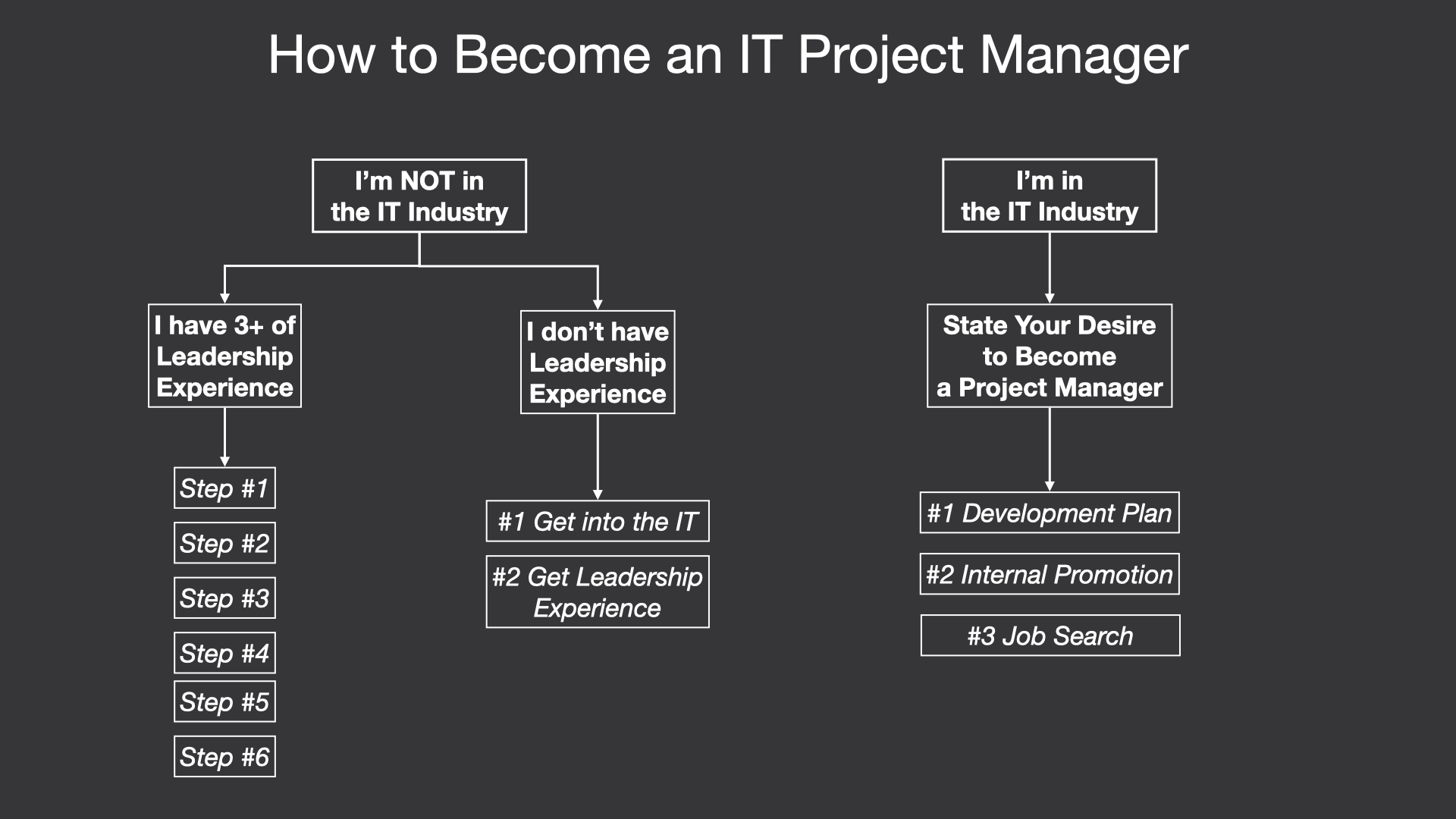
TL;DR: The steps to becoming a software project manager
- Gain any leadership experience.
- Create a CV of a project manager.
- Develop technical proficiency.
- Learn project management basics.
- Learn agile methodologies.
- Develop your interview skills.
- Apply to correct job opportunities.
That’s an overall approach that will make you a software project manager.
Nevertheless, there are lots of challenges in each step.
Below, you’ll get a FULL step-by-step guide that explains everything you need to know.
CHAPTER 1:
How to Become a Software Project Manager Without Experience, Degree, or Technical Background
In this chapter, we’ll review different paths that lead to the role of a project manager.
It all depends on your current role and level of leadership experience.
And let me warn you:
It’s challenging to become a software PM.
And sometimes, it’s almost impossible to make a direct leap into the role. So, you may need to make interim career steps.
There are two major starting points:
- Starting Point #1: You are not in the IT industry.
- You have leadership experience.
- You don’t have leadership experience.
- Starting Point #2: You are in the IT industry, AND you are in a project environment.
Choose what describes you the best.
We’ll start with the most challenging scenario:
Starting Point #1: I’m Not in the IT Industry. Where Should I Start?
So, you are not an IT specialist. You don’t work in one of the main niches:
- Software Development
- Telecommunication
- Online Marketing
- Social Media
And for sure, you don’t have a degree in Computer Science.
If that’s you, the very first thing you need to assess is your leadership experience.
No matter what industry you work in – you can’t become a project manager without leadership experience.
That’s a fundamental job requirement. You need to find a way to prove that you have a leadership talent.
Even if you have a degree in management, no one will put you in a leadership position without a proven record.
So, do you have leadership experience?
😀 Yes, I have more than three years of relevant leadership experience!
Congratulations! You are in a great place to start the career of a Project Manager.
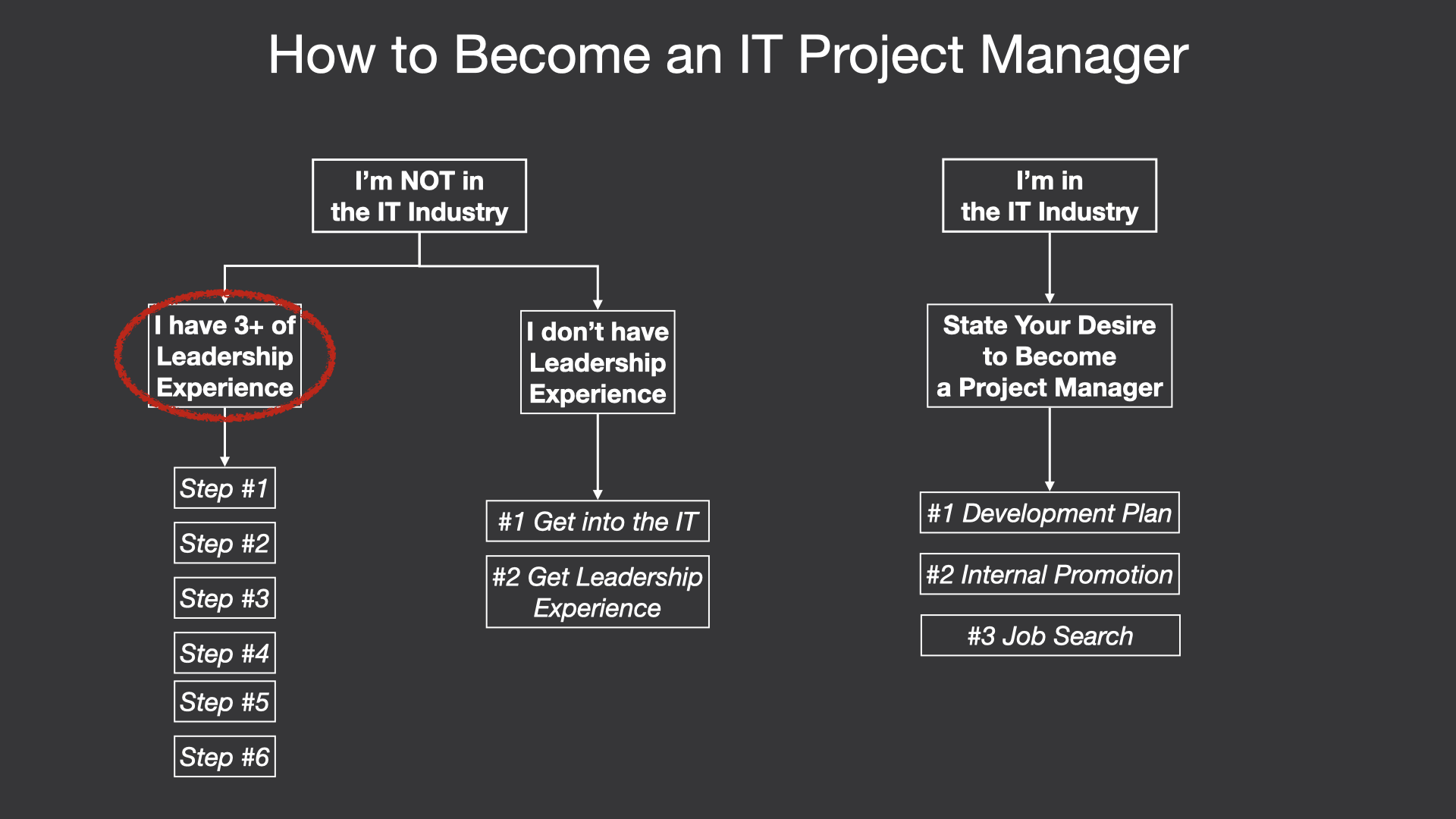
You see, I’m not asking where does your experience come from.
The truth is leadership is universal.
But I can tell you that soft skills have more value than technical ones in the IT industry.
OK, below are the six main steps you need to take.
Step #1: Learn the Basics of Project Management
I hope it goes without saying for you:
You need to learn the basics of project management.
Agile Frameworks are popular in the software development industry. However, you still need to understand the main concepts of project management as a whole.
You might think that it’s a great idea to get a Project Management Certification.
It would give you the knowledge AND a certificate. But here’s the truth:
There’s a big gap between the theory of project management and what you do in the real life.
At this stage, I don’t recommend investing in a certification.
Agile Frameworks is a Must
Additionally, need to learn a bit about Scrum and Kanban.
It’s something that interviewers will ask about.
There are a lot of resources on the internet about Scrum and Kanban.
Check out the Mountain Goat site or get the book Scrum and XP from trenches.
Step #2: Improve Your Technical Awareness
There’s a whole chapter about the technical skills of an IT Project Manager below.
Do read it thoroughly. This step is a continuous effort.
You need to improve your technical awareness during your whole project management career.
And in the IT industry, technologies evolve daily.
You need to keep an eye on the products of technical giants to be aware of different solutions.
No course will fill this gap. You need to develop curiosity in regard to new technologies.
You need to look one level deeper into new shiny things on the market to understand its pros and cons.
That’s the only way to substitute the lack of actual technical background.
Step #3: You MUST Upgrade Your CV!
You can’t even imagine it!
The majority of candidates for entry-level project manager role do not position themselves as managers and leaders.
They think that their previous unrelated experience is more important.
Why?
They think that more is better.
The more experience you have, the better your CV looks like.
That’s wrong!
How Do Recruiters See You?
Imagine that you are an engineer of some kind.
In your CV, you describe all the projects you did and all the technologies you used. You pepper it with lots of technical terms.
But the recruiter is not a technical expert. She has a list of competencies or job requirements that she must find in your CV to suggest you for an interview.
If she doesn’t find the keywords relevant for a Project Manager, your CV goes into the trash.
So, you must re-write your CV from scratch. You need to position yourself as a leader.
That’s why keep only the experience that shows your management, leadership, and communication skills.
Show your achievements in organizing people and improving something. Show your skills in communicating with stakeholders.
And remember, your CV needs to achieve only one goal. It should get you to an interview.
Step #4: Improve Your Professional Network
I’m talking about LinkedIn here.
IT Recruiters use technologies. They use social networks to find and assess candidates.
By looking at your activity on LinkedIn, I can tell quite a lot about your professional interests.
And there’s a flip side. Here’s what I see if your LinkedIn profile is outdated:
You are not active on a major professional platform. You are not using technology. You don’t understand the power of global connectivity.
You got the point. Here’s what you need to do:
- Keep your LinkedIn Profile in sync with your CV. Update it regularly.
- Start building connections with recruiters from IT companies in your area.
- Be active on the platform. Show your interest in professional topics. In our case, it’s the IT industry.
This step has a long-term effect. You’ll use your network to build a career as an IT project manager rapidly in the future.
Step 5: Build Up Your Interview Skills
Next, you need to start applying for project management jobs.
Where should you focus?
Your best bet is on smaller companies and startups.
Your primary goal is to get the first 6 to 12 months of hands-on experience on a software project.
It Takes More Interviews Than You Think
Lots of candidates quit the idea of becoming a software project manager too soon.
You apply to 10 or 20 job openings.
Maybe you fail an interview or two.
And you think that you are not a suitable candidate for the role of an IT PM.
That’s because you don’t know the statistics:
On average, each corporate job offer attracts 250 resumes. And only four to six candidates get an interview. Only one gets the job.
1 out of 250. It’s less than a percent—0.4 %.
Be Ready for Interview Grind
At some point, you’ll become a candidate that quickly gets lots of interviews.
But right now, you should apply to job openings in bulk.
Don’t overthink it.
Apply to anything related to project management just to get the experience of the interview.
And be ready that your first ten interviews will be a mess.
Step 6: Move to the IT Development Centers
It seems common sense, but I need to point it out.
If you want to build a career in the IT industry, you need to be close to the development centers. It’s still important even in the post-COVID-19 world.
If you live in a small town, you shouldn’t expect lots of job opportunities as an IT Project Manager
The IT industry is clustered in big cities. Every country has one or two such development centers.
Simply google it.
OK, it’s a life-changing step. So, I can’t recommend you how to do it.
You can try to find a job first and then make a move.
Or you can make a move to an IT center and look for a job there. It will be easier to get to the interviews.
Here’s a shortlist of major cities with a high level of software development job opportunities.
| United States | Seattle, WA Raleigh, NC Austin, TX Phoenix, AZ Salt Lake City, UT Atlanta, GA Dallas/Fort Worth, TX Houston, TX Detroit, MI St. Louis, MO |
| Norway | Oslo |
| Israel | Tel Aviv |
| Germany | Berlin |
| Canada | Montreal Toronto |
| India | Bangalore |
| United Kingdom | London |
| Australia | Melbourne |
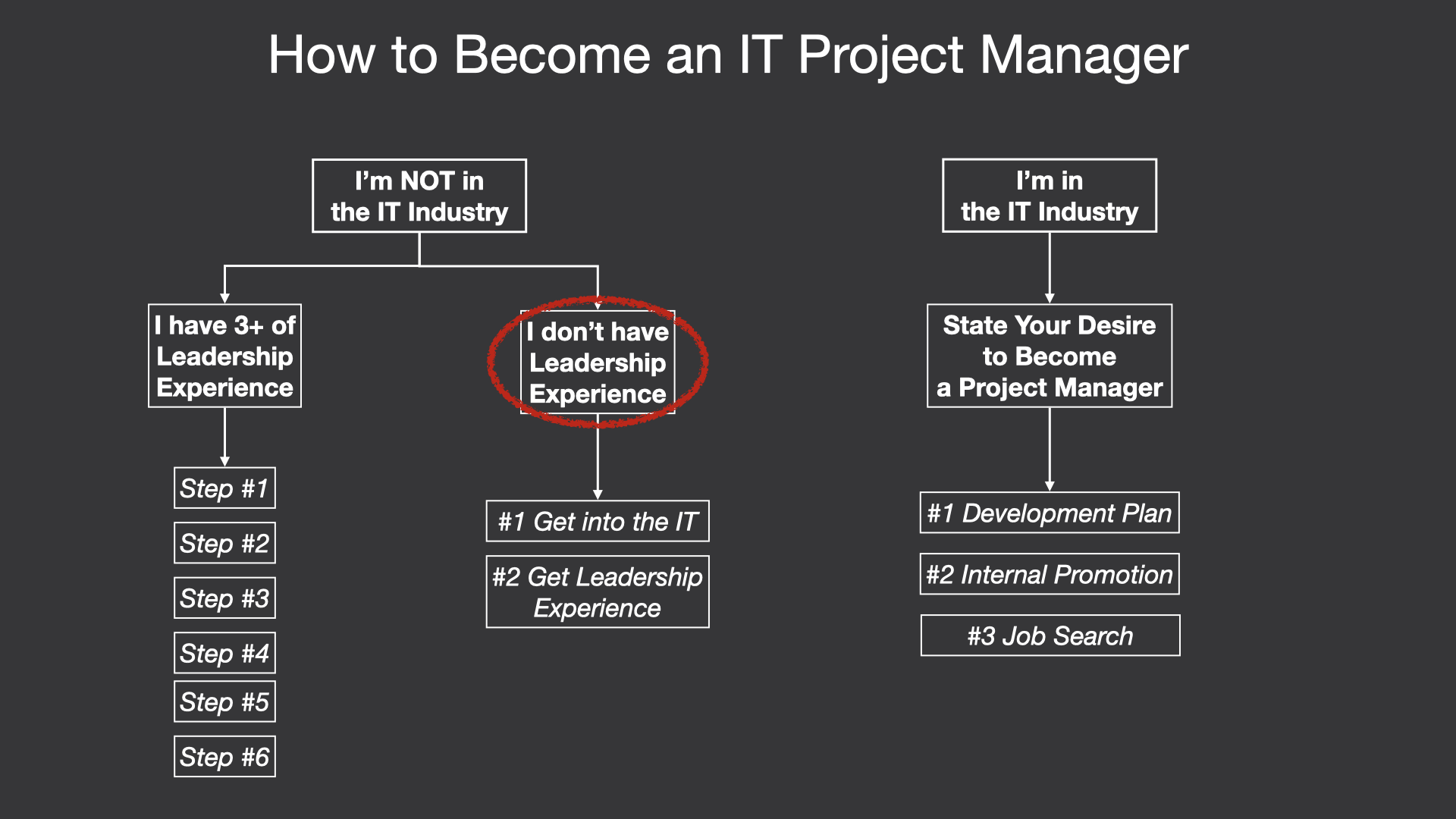
😟 Wait! But I don’t have 3-5 years of leadership experience… What should I do?
Let’s put all the challenges together:
- You are not in the IT Industry.
- You don’t have a relevant technical background.
- You don’t have leadership experience.
So, here’s the hard truth:
You can become an IT Project Manager only with a massive amount of luck.
For example, a small and unsuccessful startup may take you as a manager. They’ll pay you nothing in exchange for a chance to get some experience.
But even this downgraded opportunity is hard to find.
So, what should you do?
You need to overcome at least one of the three challenges I mentioned above.
Option #1: Get into an IT Project Environment
Focus on getting an entry-level position in an IT project. In the software development industry, the Tester or Quality Assurance Engineer is the best bet.
You can learn everything on your own very quickly. There’s a high demand for inexperienced QA resources.
Once you are inside, be sure to state your desire to become a Project Manager. Focus on getting leadership experience and looking for opportunities to do Micro Projects.
Option #2: Expedite Obtaining Leadership Experience
There’s a whole chapter on how to gain relevant leadership experience below.
You need to focus on filling out your CV with leadership achievements.
You do it at your current job.
However, I would recommend combining both options.
- Get into an IT organization and state your desire to become a software Project Manager.
- Get a professional development plan on how to become a software PM from day one.
- Then, work towards fulfilling the plan.
In the process, you may benefit from sponsorship on trainings and certifications. Most IT companies support professional development.
Starting Point #2: I’m In the IT industry. What’s next?
Here’s the insider’s secret:
The majority of leadership roles in the IT industry are covered by internal resources or from referenced candidates.
What does it mean for you?
Your boss literally can’t wait when you state your desire to become a project manager.
So, the only thing you need to do is to go to your boss and inform him or her.
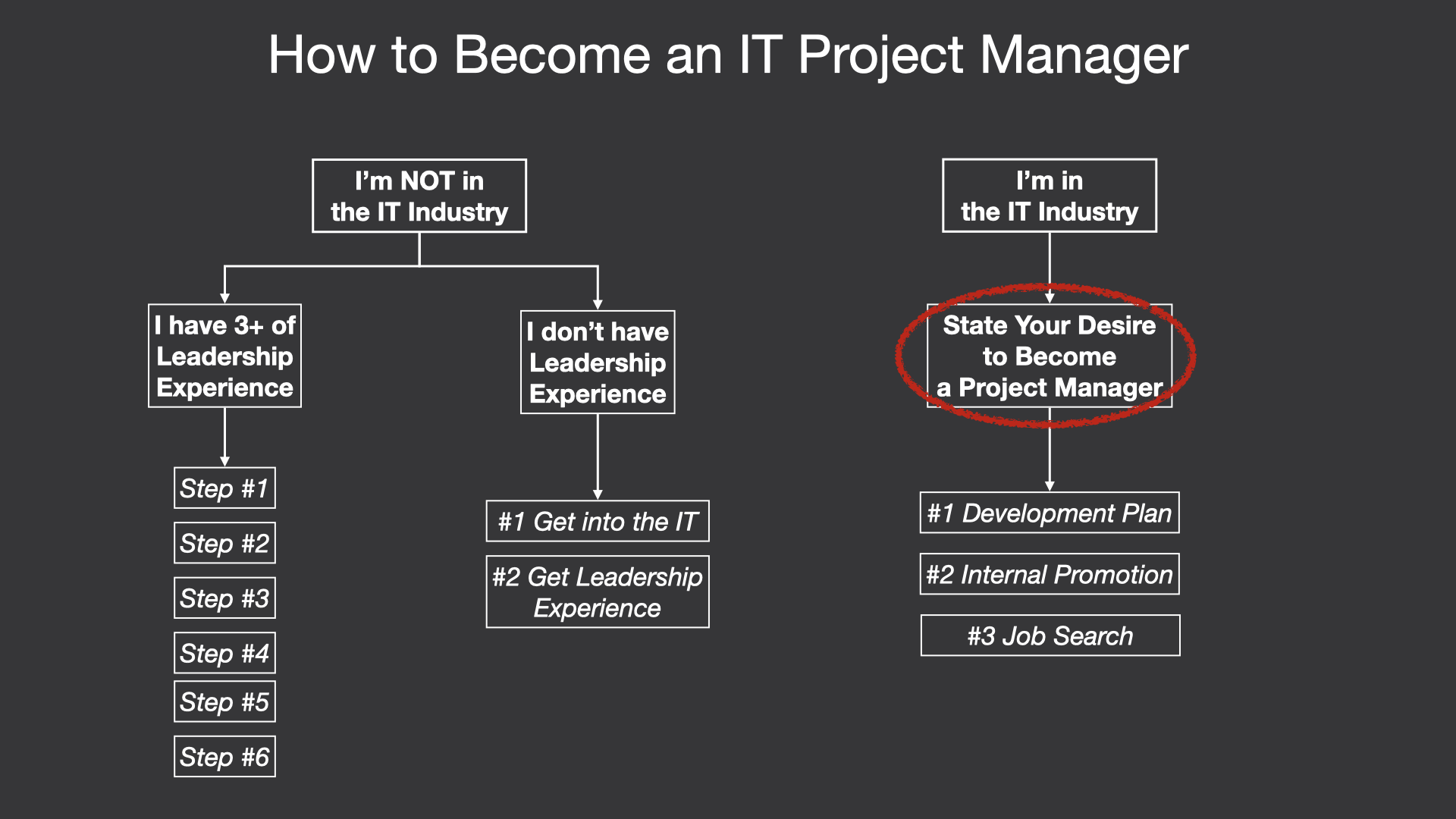
Here’s what might happen next.
Your Boss Doesn’t See You as a Software PM.
That’s bad, but it’s the outcome on its own.
It might happen for a few reasons:
- The organization doesn’t have small projects for entry-level PMs.
- Your boss doesn’t like you.
- Your boss can’t decide on the spot.
You need to know the real reason. If it’s #1 or #2, you need to change the company.
If it’s #3, you need to repeat your attempts several times more.
You Get a Development Plan
Good. Your boss gave you a set of requirements you need to meet. Then, he or she will promote you.
Do your best to learn and achieve everything that is on the list.
But what’s even more important:
Do communicate your progress regularly. Stay at the top of her mind. Show that you are serious about it.
Then, take all possible opportunities to get trainings inside the company on project management. Or get sponsorship for trainings or certification.
You Get a Promise to Find You a Project
Congratulations! Now you need to wait for the opportunity.
But don’t wait passively.
A new project may not appear for a few months. So, you need to keep reminding about yourself and that you ought to cover a new opening.
It’s still your responsibility to get that opportunity. Don’t expect that your work is done.
CHAPTER 2
Technical Skills of a Software Project Manager
“I do not have the technical skills to become a software development project manager.” I hear this all the time.
However, here is a catch.
No one expects you, as a project manager, to write code or set up servers.
You do need to know the software development process that goes into creating software applications.
So, in fact, you don’t need to have technical skills. You need technical awareness.
OK, I get it.
All those terms and technology alone are too much. Coding by itself looks so complicated and out of touch.
However, only for a short period of time.
Once you are surrounded by software engineers, QA, BAs, and so on, you start to learn everything like a sponge.
In a month or two, ordinary people would not understand you. You will use so much slang…
But you do need some initial set of terms to learn.
So here we go.
The Glossary of a Software Development Project Manager
Note: This chapter is for project managers by a project manager. If you have an engineering background, it may hurt reading this. I warned you!
Hardware vs. Software
These two are simple:
Hardware means all kinds of computers and mobile devices where your software will be used at. It is your Mac or PC, printer or server, iPhone, your car, refrigerator, or smartwatch.
Software is actually all the software applications and programs on the hardware you use. It includes apps that you use on your Mac, PC, smartphone.
But it is also firmware on your microwave, drivers in your printer, photo camera, etc.
Team Composition on a Software Project
Software Engineers are people who write code (or source code) and do all the mental work to develop a software application.
You can also use the term developer interchangeably.
Don’t use “coder”, as many software engineers despise it.
Quality Assurance Engineer (QA) is a person who ensures that the application your developers created is of the required quality.
Tester or Testing Engineers are people who actually test the application or service.
Often, these roles are used interchangeably. However, as you may know, there is a difference.
QA Engineers should focus on developing proper processes to assure quality.
Testers focus on controlling quality. It means they test and state the defects they found.
Their goal is to verify the quality level of the application.
Business Analyst work with customers and other stakeholders to understand the business requirements of a project.
Sometimes, he needs to identify them by researching a market and demand. Sometimes, he just needs to communicate with stakeholders.
After that, he needs to translate business requirements into specifications or user stories.
User Interface (UI) Designers and User Experience (UX) Designers are people of art. They work with the team to understand the requirements.
Then, they draw the design of the application or service.
If you open any standard application on your Mac, you will see an example of the hard work of a team of UI/UX designers.
Writing Code
So here is how it works:
A Software Engineer writes code.
She uses a Programming Language.
A programming language is a set of formal instructions to a computer or a mobile device. Every programming language has its syntax, semantics, and core programming principles.
For example, applications on iPhone are written in Objective C or Swift. On Samsung phones (and other Android phones), they use Java.
Here is the list of ten major programming languages you need to google about:
- C
- Objective C
- Ruby
- JavaScript
- C# (C Sharp)
- PHP
- SQL
- Java
- Python
- Swift
A bit deeper knowledge
The code that software developers write is human-readable to some extent. These are instructions
It is not something that a computer can understand.
That is why this code is compiled and transformed into machine code that hardware can understand. It is called lower-level code.
Core Libraries, Frameworks, and Kits
Also, you need to understand that programming language is only a set of standard functions to implement and group logic, store and represent different types of data.
It is the engineer’s work to find a way to use available means to implement an application.
However, it would be very time-consuming if each time each engineer should implement some basic algorithms and functions.
Also, it would be hard to write code that will work directly with the hardware you use. For example, to use a camera or speaker on your phone, different sensors, motors, etc. It is a lower level of programming.
That is why many programming languages come with Core Libraries or Frameworks.
In these libraries, you can find standard and frequently used functions.
They can be developed by enthusiasts to make life easier. Alternatively, they can be created for commercial use and sold to software engineers.
Also, companies that produce hardware usually supply such libraries to help developers to use their devices.
For example, Apple provides numerous libraries that make it easy to use all the built-in features of iPhone or Mac.
So, developers do not need to implement everything from scratch.
Integrated Development Environment (IDE)
The code can be written on a napkin, in a notepad, or in MS Word.
But it is not convenient.
You have to memorize all the functions, libraries, and structures by heart. To say nothing of possible mistakes.
That is why developers use Integrated Development Environment or IDE.
IDE is a separate application developed specifically for software engineers to work in. In essence, it is a code-centric text editor.
It makes code easier to read visually by highlighting, coloring, and structuring the text.
It also contains documentation on the programming languages and core libraries. Moreover, it makes it easy to add more of the core libraries if needed.
There are also tools for debugging. There is a built-in compiler. And much more.
There are many IDEs. Some are free. Some are paid.
Microsoft Visual Studio, Xcode, RubyMine, Eclipse just to name a few.
Each IDE can work with several programming languages.
Source Version Control
In essence, code is just text.
This text is stored in files.
Files are organized in folders (source tree).
There might be hundreds and thousands of files.
Some code is written once and never changed in years. Some files are altered on a daily basis by many developers.
The code is interdependent. Code from one file can use code from other files.
Keeping a record of all changes to the code is essential. Moreover, it helps a lot when you can revert to an older version of the code.
That is why developers use Source Version Control.
The proper use of Version Control is the cornerstone of quality assurance in software development. You do want to learn more about it.
So, a developer writes a piece of code or updates an existing one. He has to ensure it works as expected and doesn’t break the rest of the application.
After that, he makes a Commit of his code into Source Version Control.
SVN and Git are the examples of Version Control Systems.
Layers of Application
In Web development, you will also hear a lot about front end and back-end parts of an application.
Front End is the part of the application that you see on the screen of your device. So, the design, layout, buttons, and text right on this page is the front end.
(HTML, CSS, JavaScrip are the programming languages of the Front End)
Back End refers to the server side, database, and logic of the web application. So, this very article is stored in a database on a server. This site uses MySQL as database management system.
(PHP, Ruby, Python are the Back End languages)
Deliverables
So, what are the end results of a software project?
First of all, it is the source code. All the code created during the project is transferred to the client.
Sometimes, you store the code in the client’s Version Control system from the start. So you just need to commit all the code there.
Sometimes, the code should be archived and sent to the client. You do it just like you would do with any folder with files.
However, more often, software development projects include the work required to deliver the application to the end users.
So, in case of iPhone, Mac, or Windows applications, you will compile the code and create an application (installation) file. It is a built-in functionality of every IDE.
You may also need to submit this application to one of the main markets – App Store, Windows Market, Google Play.
Nowadays, it is a relatively user-friendly process. No harder than uploading a photo to Facebook. Though with more steps.
In the case of a Website (web application), you need to deploy the application to a server. If the application is complex, it can be a task in itself.
Chapter Conclusion
For sure, it is not a comprehensive list of all technologies you will face. Also, you will need to get a bit deeper into every term I used here.
But let’s be honest, it’s not that complicated. And you can find a simple explanation to the most complex technical topics.
Here is what I suggest you to do:
- Start googling these terms from the perspective of “for dummies“.
- Keep to one topic/term at a time.
- List other new terms that you will encounter.
- Google new terms until you have a bigger picture.
- Find a friend or a colleague (developer, experienced IT PM, etc.) and ask them to explain everything in more detail.
- Develop a curiosity habit. Look around at all the tech around you and ask yourself, “Do I know how it works?” If not – google it.
CHAPTER 3
How to Gain Initial Management Experience
So, you noticed that you need one or two years of relevant experience as a project manager.
For an entry-level role of a project manager!
I get it. It’s frustrating.
You want to get your first job as a PM. But they want you to have some experience.
In this chapter, I’ll share some insights and tricks on how to get that “relevant” experience.
And here’s what you need to understand:
Trying Things Out Also Counts
Relevant experience does not equal the experience in the capacity of a Project Manager.
It means you need to have experience similar to what a PM does.
Recruiters don’t even mean skills in using project management techniques or tools.
Here’s the catch:
A project manager organizes people to do a work in a controlled and predictable way.
You need to have skills in working with people. Specifically, you need to know how to organize them.
But…
You need to do it in a way they like.
Here’s more:
A project manager keeps the wheels turning.
What does that mean?
Well, it means everything and anything.
You need to do whatever it takes to push the project to its goal.
Quite often, it requires you to make decisions.
Therefore, you’ll have to take responsibility for those decisions.
In the process, you’ll need to communicate a lot.
That’s actually it.
These are the areas where you need relevant experience:
- Organizing people
- Making decisions
- Taking responsibility
- Communicating
Notice there’s no dependency on any project management methodology or technique.
So, here’s what you can do:
1. Take an Unofficial Vacant Leadership Position
A leadership vacuum is always present in any company and on any project.
People in official leadership positions can’t address all the needs.
You can always find an opportunity to improve something or help someone.
Therefore, you can become an unofficial leader for a small group of people. Now, you can try to organize them to act upon a problem.
Ideally, you need to get support from your boss. At the very least, you need to inform him or her about your endeavor.
Your efforts shouldn’t be unnoticed.
In the end, you’ll want to put this experience into your CV.
So, here’s what you need to do:
- Identify a problem worth dealing with.
- Select a solution.
- Implement the solution:
3.1 Organize people, don’t do it yourself
3.2 Measure your progress – you need numbers in your CV.
3.3 Communicate with your boss to validate results.
3.4 Take responsibility for the outcome. - Describe “before and after.”
- Explain it as if you planned it all from the beginning.
2. Build a Career of an IT Project Manager One Step at a Time
I know for sure it’s difficult to leap right into the position of a Project Manager.
It’s even harder when you have no experience in a leadership position.
Don’t try to force your way to the top skipping several steps on the ladder. Make a natural progression step-by-step.
It may take longer. There’ll be roadblocks.
But you’ll gain valuable experience in the process.
Moreover, you’ll be under less stress.
So, look around your current company.
Do they have a leadership role?
Anything will do that will allow you to state:
“I lead a group of five persons…”
“I managed a small project of seven team members…”
“I was in a leadership role…”
But here’s an important tip:
You should always keep your ultimate goal in mind. All the interim steps should help you transition to a PM role.
It means you need to be transparent with your management about your intentions to become a Project Manager.
Most of the time, it will work to your advantage.
3. Become a Volunteer
OK, I get it.
There might not be official or unofficial leadership roles in the organization you work in.
However, there’s always a cause that would benefit from the proper organizational effort.
It may not be a full-time job. It may not be a project.
Remember that you need to gain experience in organizing people, making decisions and communicating.
Yes, it’ll be free of charge. You need to do some extra work.
Here’s the key:
You need to approach any opportunity from a perspective of a Project Manager.
As much as possible, you need to apply the project management basics.
Check this article to see what I mean:
Project Management Basics That Will Make You a Better PM
Why do you need this?
You need to see and feel resistance from the people you will lead.
They will be eager to do something useful. But they will not want to follow the lead. They will not want to be controlled.
At least at the beginning until they see the benefits of your efforts to organize them.
And you need to sell them the benefits of project management. However, you may need to use simple words.
Here’s one more tip:
For sure, you will put such experience in your CV. Nevertheless, there should be a story behind it.
And here’s what will make it powerful:
“You should NOT say that you accidentally got such experience. It was your educated decision to try yourself out in a leadership position.”
You volunteered because you knew it would be a challenge and experience you needed. Frame it this way and do include your efforts to apply project management.
4. Become an Assistant Project Manager Now
Last but not least – look around. What do you see?
If your company does projects, you see some project managers.
Most likely, you’ll see experienced PMs.
Why?
Junior PMs are doing some routine tasks right now. Experienced managers do something meaningful, visible, and tangible.
(What Does it Feel Like to be a Project Manager (True Story))
So, it may feel like your company only needs such experienced Project Managers.
You may feel like you need to learn first, gain experience, get a certification.
But here’s the truth:
A company wants the cheapest labor it can get.
If they can get a Project Manager for half the price – they will do it.
Moreover, it’s much easier to find a substitute for you than a suitable project manager.
But there’s only one problem you need to overcome:
They’re not ready to entrust you with their clients and people. And it’s not about your knowledge and skills. It’s about how responsible and reliable you are.
So, communication comes into play.
You need to become a savvy communicator.
You need to keep your management well informed about your progress in learning the basics of project management.
You need to keep your name at the top of their minds. You should be an easy solution for the next opening.
It also helps to get a mentor inside the company.
This person will know your abilities and knowledge firsthand.
He or she will understand what kind of a project manager you can become.
Most importantly, this person will provide feedback on you when the time comes.
Conclusion: Relevant Experience of a Project Manager
Is it hard to become find relevant experience or a project manager?
No.
Is it hard to leverage the opportunity?
Yes.
You need to overcome a lot of objections. You need to have a specific set of basic knowledge of project management. You need to be confident in communicating with your management.
CHAPTER 4
Do You Have What It Takes to be a Software Project Manager?
Before you get into all the nitty-gritty of becoming a software Project Manager, I want to make this career change sweeter for you.
In this chapter, I want to explain:
- Why it’s a great idea to become a software PM.
- Different levels of project management.
- Roles and Responsibilities of a Software PM.
3 Top Reasons to Become a Software Project Manager this Year
Software Project Manager is not the easiest profession.
So, why would you want to embark on this journey
Here are three main reasons:
1. Substantial Increase of Salary
The statistic shows that people in project management roles earn 82% more than people in none-leadership roles.
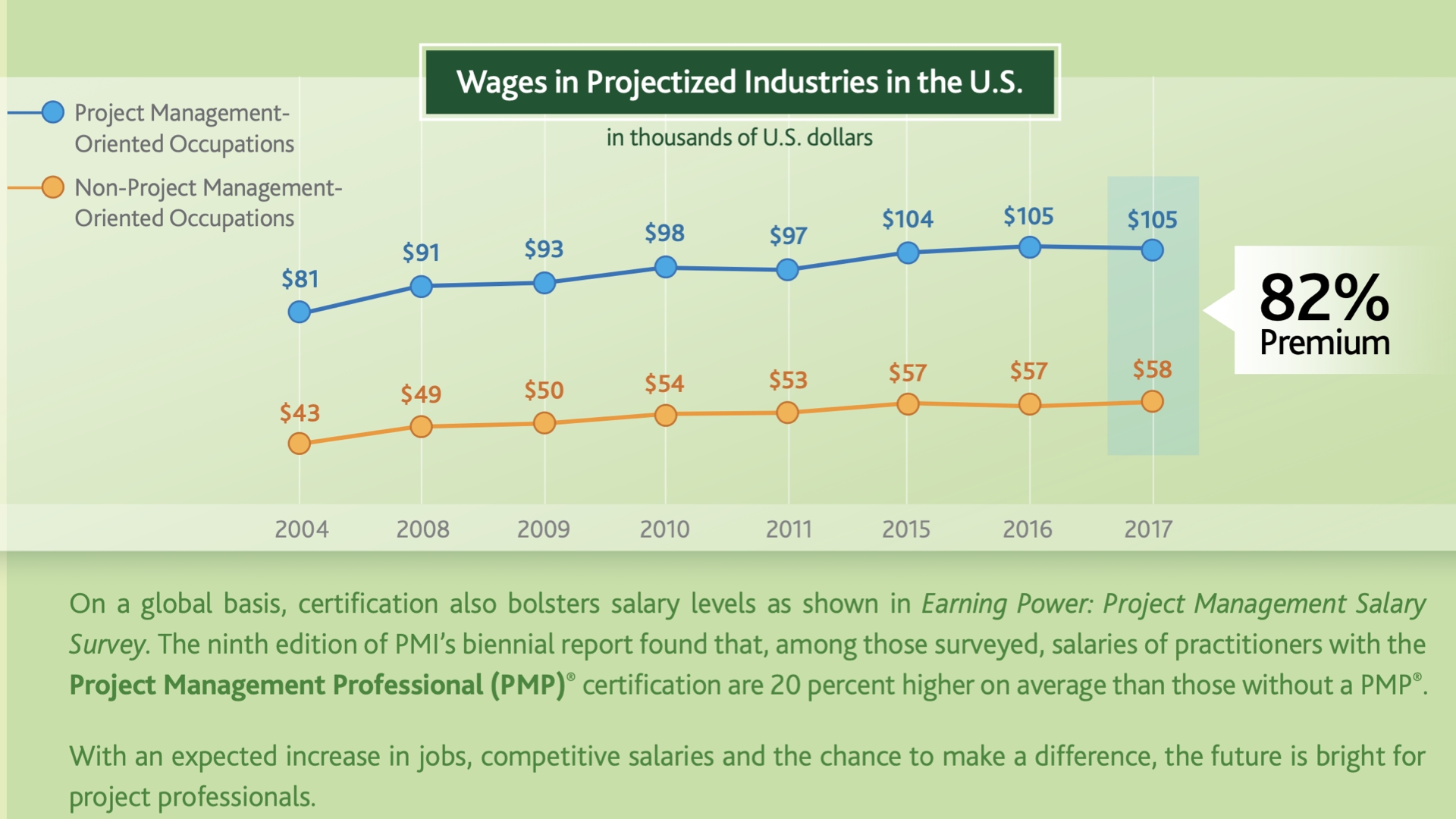
That will provide a higher income at the start. It will also give opportunities for salary raises for the next few years (decades?).
2. Lots of Job Opportunities for IT Project Managers
The Project Management Job Growth and Talent Gap Report from the Project Management Institute states that the IT industry is the second leading sector in job openings.

What does that mean?
With current trends, the demand for IT Project Managers will be higher than Educational establishments can provide.
And it won’t change for years to come.
That’s important for you because a degree in Computer Science becomes a desirable requirement. It can’t be mandatory with these numbers.
3. The Profession that Keeps You Engaged
I know your kind. If you consider becoming a project manager, you feel a nagging desire to lead.
You want to take over the control and do things better.
Most likely, you are a natural-born leader, and you know the value of motivating and helping people.
And sciences show that helping others is the most fulfilling activity. It brings happens.
Combine it with the challenges of cutting-edge technologies. Add smart people you work with and the freedom to make it your way.
It all constitutes a perfect profession. You’ll fulfill your leadership potential. It will keep you happy and motivated.
But it feels like a demanding role.
Why am I so sure you can start a career as an IT Project Manager in any role?
Here’s what you need to know:
There are Different Levels of the IT Project Management!
Let me take a step back from the IT industry and illustrate it on construction projects.
I’ll show you three pictures:
Here’s a project for home renovation. The budget is somewhere 50 thousand dollars. It will take two-three months to complete. 10 to 15 people on the project team.

Here’s a project to build a multistoried building. It’s a two-million-dollar project. It will take a year to finish the building. And hundreds of people will work on it.

And here, someone’s building a stadium. Most likely, it’s even a group of projects. With all infrastructure, it may cost anywhere from $500 million to $1.9 billion.

And here’s the catch:
There’s a project manager on all of these projects.
Do we put a manager who built a stadium on a renovation project? No.
Do we need the same skillset to build a house and to do repairs? No.
You got the point.
Projects vary in size and complexity. There are more small projects than huge ones. Smaller projects don’t require a degree, expert knowledge, or certification.
That’s your way in.
What Does Project Look Like in the software industry?
Just a side note.
Why didn’t I show you the IT project as an example?
They all look the same like this.

People are staring at displays and typing. You can’t tell whether it’s a huge enterprise project or a garage start-up.
Moreover, the number of people doesn’t communicate the scale of a project.
{table number of employees in different companies}
That leads us to the next thing you need to know:
What Are the Job Responsibilities of a Software Project Manager?
If you don’t need a degree, technical background, or specialized training, what does an IT Project Manager do?
Let’s break it down.
You’ll Communicate with Clients
Different kinds of communication will take up 80% of your time.
You’ll be the primary communication point between the people who started the project and the project team.
It doesn’t mean you’ll just transfer information and request from the client to the team.
You’ll have to bridge the gap between business people and technical experts. Keeping both camps happy.
You’ll Obtain Expert Knowledge and Expertise
You will need to understand the business needs of the clients. You’ll then go to your team to find a technical solution that will meet that business need.
Again it requires lots of communication.
And you can’t just throw technical specifications to the clients. You’ll need to find ways to explain complex technical problems with simple words.
You’ll Have to Make Decisions
This one is huge.
You know the business need. You have some technical solutions with pros and cons.
Now, you’ll need to make lots of decisions as to what to do and how.
But, again, you’ll seek expert knowledge from your team and other experts.
You don’t do it on your own.
However, the responsibility for the final decisions is always on you.
You’ll Need to Select and Establish Processes
The IT industry is ahead of the world in the adoption of Agile Frameworks. You’ll execute most of the projects with Scrum, Kanban, or SAFe.
It makes it much easier on this front on smaller projects.
Nevertheless, you do need to learn the project management basics to be a successful software PM.
You’ll Lead and Motivate Everyone
There are pros and cons to working with educated and smart people.
The main disadvantage is that they know a lot and they have critical thinking:).
So, a big salary and a cute office are not enough to motivate them.
You’ll need to put lots of effort into people management.
By the way, clients and other stakeholders are human beings, too. They need your encouragement as well.
You’ll Resolve Conflicts a Lot
It’s not only about personal conflicts between team members.
That’s the easiest part.
On a project, you’ll face conflicts in requirements and policies. There will be conflicts between stakeholders and their expectations. Conflicts between wants and allocated resources.
So, conflict resolution is a constant thing in project management.
Chapter Conclusion
The profession of an IT Project Manager is one of the best leadership roles.
Moreover, the opportunities to become an IT PM are on the rise.
You don’t need experience, a degree, or a technical background to manage smaller projects.
These projects are your entry point.
Next Step: Learn Project Management
The fact is this article was just one piece of a complex project management framework.
If you are like most project managers, you don’t have formal education. It means you must collect bits and pieces from such articles and YouTube videos.
You have two options now:
Option #1: Try to figure it all out on your own and slow down your career for years.
Option #2: Let me explain the whole project management framework in 45 minutes.
My Full Project Management Tutorial explains how project management works in the real world as a system.
Don’t put your projects and reputation at risk. Ensure you know how all critical processes and tools work.
All successful project managers know it’s better to learn from someone else’s experience (aka lessons learned). Tap into my 12 years of practical IT experience and get access to the Full PM Tutorial now.

